In “Reaping the Rewards,” I take a look at a finished version of a crowdfunded project. Today’s topic is Vast: The Crystal Caverns, a game I’ve really been looking forward to.
Last fall, I reviewed a Kickstarter game (at the time called Trove*) that was unlike anything I’d played before. Each player takes on a role and has an objective and a set of rules that is unique to that role—but somehow these very disparate roles mesh together as a single game. Vast has changed a bit since the Kickstarter campaign: several of the roles were tweaked and changed (particularly the Goblins), and there was a fifth role added as a stretch goal: the Thief. Here’s a look at the finished product.
At a glance: Vast: The Crystal Caverns is a game for 1 to 5 players, ages 10 and up, and takes 60–90 minutes to play (though this varies significantly based on the number of players and experience level). You can currently place a pre-order at the Leder Games website for $50 (in the US; other locations add costs for shipping); I believe retail price will be $60. I have played this with my 9-year-old daughter, and I think you could play it with kids younger than 10, but some roles are easier to handle than others and they do need to have the patience for a longer game.
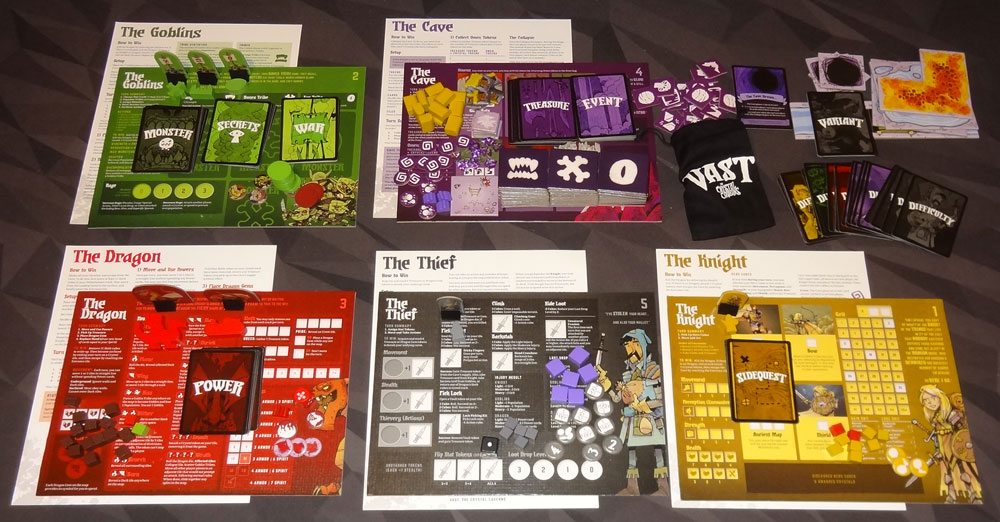
Components
Vast has a lot of components. Each of the roles has its own board and some set of pieces, plus potentially some additional cards. Each role also has its own rulesheet, which reproduces the two pages in the rulebook for that character, so that you can hand those out to each player for easy reference. (The rulebook includes additional information like initial game setup, rules for the optional terrain tiles, and explanations of how to play with various combinations of roles.) Because of Kickstarter stretch goals, many of the components come in both wooden and cardboard versions.
I’ll list the components by roles.

Cave
Although the Cave isn’t the first player, it has the most components, and many of these are used in every game even if there isn’t a Cave player, so I’ll start with it.
- Cave board
- 7 Treasure Cards
- 15 Event Cards
- 52 Cave tiles:
- 1 Entrance tile
- 15 Ambush tiles
- 9 Crystal tiles
- 15 Event tiles
- 6 Treasure tiles
- 6 Vault tiles
- 10 Event tokens
- 3 cardboard Rockslide tokens/3 wooden Rockslide tokens
- 9 cardboard Crystal tokens/9 plastic Crystal tokens
- 12 cardboard Treasure tokens/12 wooden Treasure tokens
- Cloth bag
- 36 Omen tokens
- “The Cave Grows” card

Knight
- Knight board
- 3 Bomb tokens
- 7 Hero cubes (yellow)
- 1 Grit cube (red)
- 1 Health cube (red)
- 10 Sidequest cards
- 1 cardboard Knight pawn/1 wooden Knight pawn
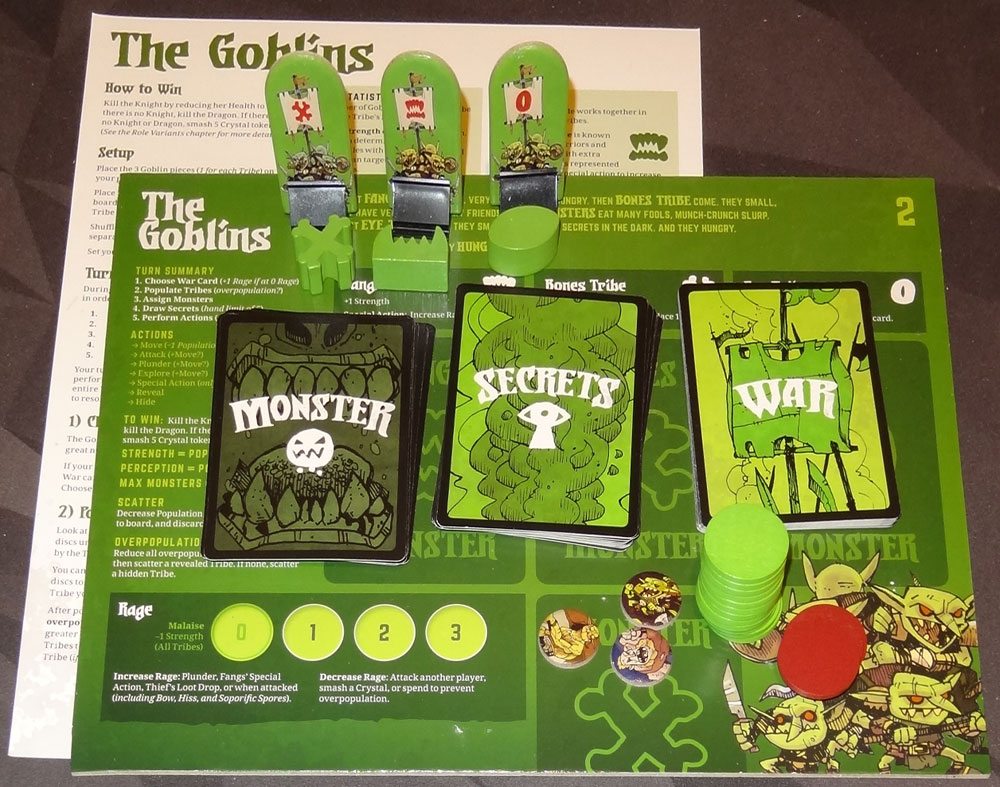
Goblins
- Goblin board
- 12 Goblin discs (green)
- 4 Strength discs (red)
- 1 Rage token
- 2 Monster tokens
- 10 War cards
- 10 Secrets cards
- 10 Monster cards
- 3 cardboard Goblin Tribe pawns/3 wooden Goblin Tribe pawns (Fangs, Bones, Eye)
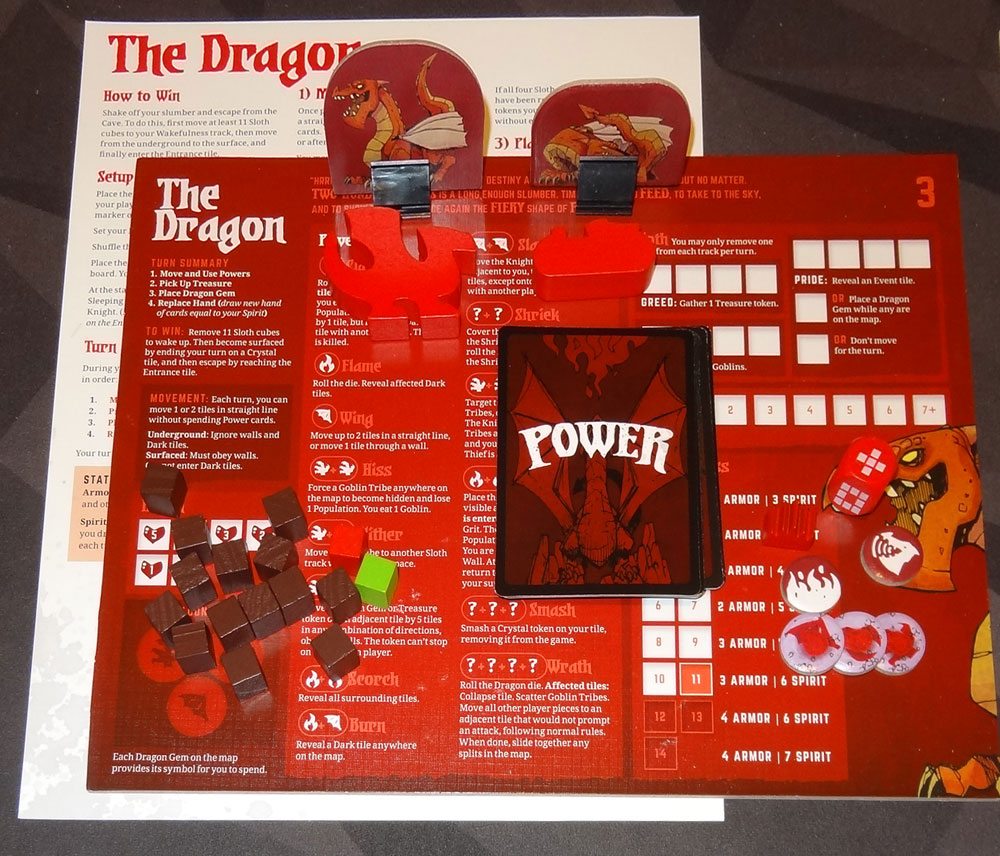
Dragon
- Dragon board
- 1 Shriek token
- 1 cardboard Flamewall token/1 wooden Flamewall token
- 1 wooden Dragon die
- 18 Power cards
- 2 cardboard Dragon pawns/2 wooden Dragon pawns (Slumbering, Awakened)
- 14 Sloth cubes (brown)
- 1 Eaten Goblins cube (green)
- 1 Health cube (red)
- 3 Dragon Gem tokens
The Dragon die is a wooden die with rounded corners, silkscreened with 6 different patterns—it’s not a typical 6-sided die. Instead, it shows various patterns on a 3×3 grid, representing the tiles affected by a particular power (with the player’s location at the center of the die).
My only complaint about the Dragon’s board is that the layout of the “Pride” category of Sloth is confusing. There are 6 cubes in Pride, and 3 ways to remove them. However, it looks like there are 4 cubes that can be removed with the first method, and then 1 cube each for the other two methods. It’s something I have to explain every time I teach a new player the Dragon. Correction: After chatting with Patrick Leder, turns out I’ve been playing it wrong, so the board is actually fine as it stands, though the line in the rules about this is a little unclear.

Thief
- Thief board
- 3 Stat tokens
- 1 Action die
- 5 Action cubes (grey)
- 6 cardboard Vault tokens/6 wooden Vault tokens
- 1 Loot Drop token
- 1 cardboard Thief pawn/1 wooden Thief pawn
One note about the Thief’s board: the “+1” notations on the Movement, Stealth, and Thievery only count once you have upgraded it, so it can be a little confusing that it says +1 right there. I wish there had been another way to lay that out to make it more obvious.
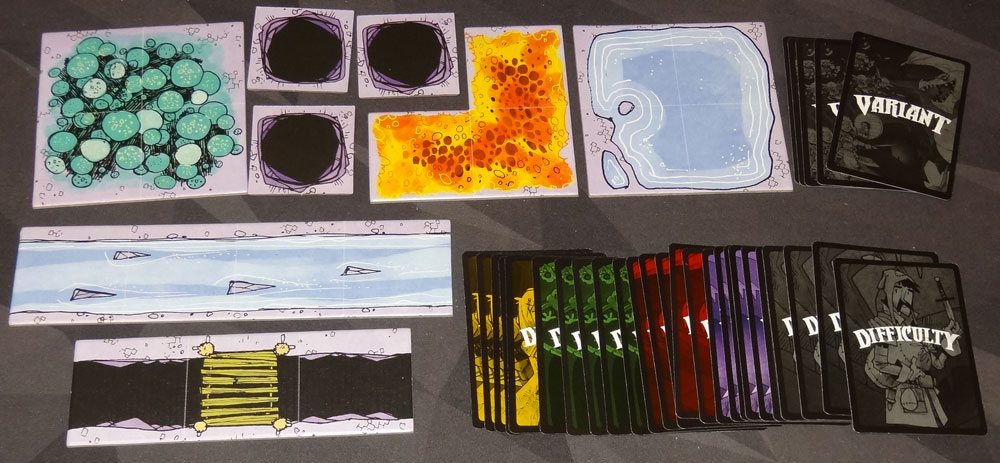
Additional components
- 8 Terrain tiles
- 5 Role Variant cards
- 25 Difficulty cards (5 per role: Easiest, Easy, Standard, Hard, Expert)

The wooden pawns, which were included as a stretch goal, give you more options to choose from. My kids really love using the wooden bits for everything, but I also really love Ferrin’s art. The one downside: the included plastic stands cover up too much of the artwork. I’ve swapped these black plastic stands out for some translucent ones that don’t clip quite as high. The wooden meeples are a lot of fun, too, but I personally think the Slumbering Dragon pawn looks a bit like a rubber duck.
The only other odd choices in the wooden pieces were that the Thief’s vault tokens are purple squares—but purple is usually the Cave’s color, so that can be odd. Also, the wooden treasure tokens are the same color as the Knight’s wooden pawn, so when the Cave is counting treasure tokens, it can be easy to mistake the Knight for a treasure chest at a glance.

The Difficulty cards allow you to handicap the game per player, based on that role’s objective. For instance, the Goblin’s goal is to kill the Knight, so the difficulty levels simply adjust the Knight’s starting health. On harder levels, the card is actually placed next to the Knight board to extend the health track. There’s a suggested mega-campaign variant in the rulebook: start everyone on Easiest, and every time you win a game, you go up one difficulty level (regardless of which role you’re using). To win the campaign, you must win on Expert level.
Overall, the component quality is excellent: the cardboard tokens are fine, the cards are pretty good quality, and the wooden tokens are a fun alternative to the cardboard bits, although the cardboard bits include the artwork. Speaking of the artwork, the illustrations by Kyle Ferrin are fantastic and I really love it—it’s not your typical fantasy art and it’s got a lot of character to it. Pretty much all of the cards (except the Difficulty cards) have flavor text on them, which isn’t necessary to the game but is a lot of fun. Each player board has some flavor text on it, too (although the Thief’s is a little weak, in my opinion). If you just look at the components alone, I think you’re getting your money’s worth, and it surprises me that the retail price on this is only $50 (compared to the original Kickstarter pledge of $45); I was expecting this to retail for more. The Terrain Tiles and Difficulty cards were included even though the original Kickstarter campaign did not hit those two stretch goals, so that’s a big bonus.
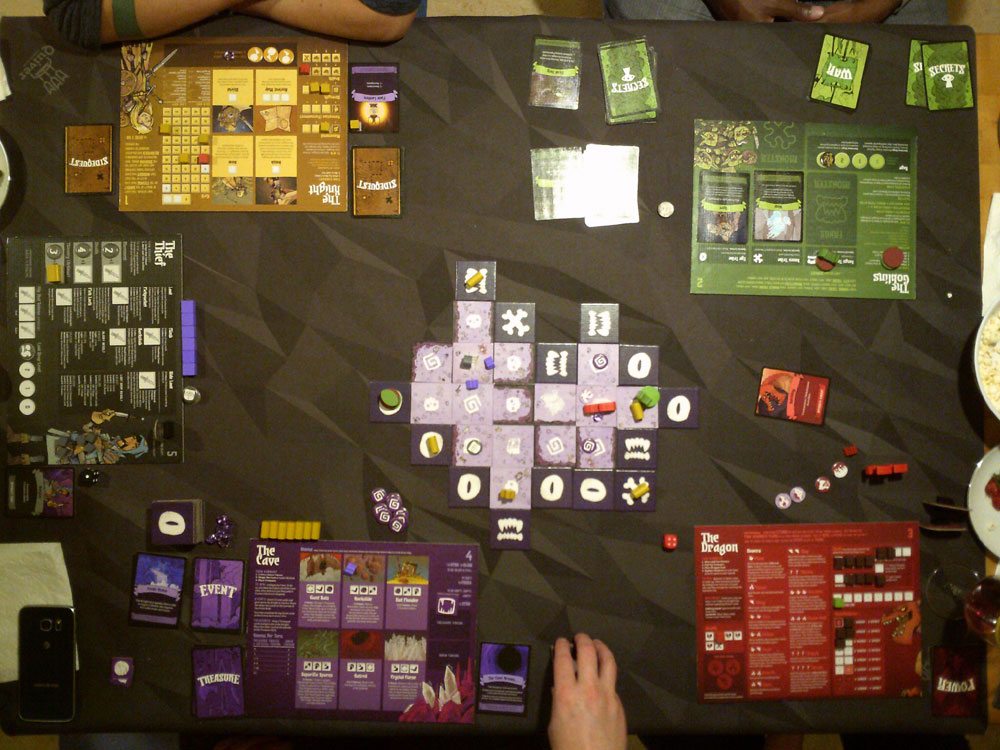
How to Play
The rulebook is available for download here, in case you want to see all of the details.
Each individual role in Vast is not too complex (2 pages each) but explaining each role in detail here would take a lot of space. I’ll give a quick overview of each one rather than a detailed how-to-play, particularly since the gameplay has changed since my original summary during the Kickstarter campaign. I’m considering creating some more detailed how-to-play videos, one per role, though that will have to wait for now.
Depending on the number of players, you’ll use different roles, and objectives may change somewhat—there’s a section in the back of the book outlining the variants, including every possible combination of characters from 1 to 5 players, with the exception of solo rules for the Cave. So there are 30 different possibilities. The turn order of the players will always be in the same order, though, omitting the missing players.
Each role has a different victory condition:
- Knight: Kill the Dragon.
- Goblins: Kill the Knight.
- Dragon: Wake up fully and escape the Cave.
- Cave: Fully expand and then collapse on everyone.
- Thief: Stash 6 Treasures or Dragon Gems.
The Variant cards come into play when certain characters are not present. For instance, if the Knight is present but there is no Goblins player, there’s a card that explains what happens when the Knight reveals an ambush tile. If the Dragon is not present, typically another player gets the Flare card, which allows that player to reveal tiles (in a way similar to the Dragon’s Flame ability).

Knight
The Knight starts on the Cave Entrance tile, with four cave tiles adjacent to her, face down. She starts with 2 hero cubes, full health (marked on the sheet), 0 Grit, and 3 randomly drawn Sidequests in her hand, secret from other players. The Grit marker has spaces for the remaining 5 hero cubes. The Knight board has various places to assign the hero cubes–movement, perception, strength, and various equipment like a Torch or Bomb or Bow. The default is 1 movement point, 1 perception, and 1 strength. Perception determines how many encounters she may have in a turn, and also her ability to see the Thief.
- Shield: other players may not move the Knight, and reduces Grit loss to 1.
- Bomb: the Knight may attack the Dragon while it’s still underground, once this turn.
- Bow: the Knight may attack Goblins in your line of sight, once this turn.
- Ancient Map: the Knight may walk through one wall per hero cube, up to 3.
In addition, as the Knight collects treasure, she may acquire equipment that may require hero cubes to use, or she can decline the treasure to earn 5 Grit.
An encounter encompasses everything that happens on a single cave tile: revealing a dark tile, resolving events, fighting, and collecting treasure are all collectively a single encounter if it’s on one tile. The Knight earns Grit through various means: revealing tiles, fulfilling Sidequests, killing the Thief, and so on. Every time her Grit cube reaches a space with a hero cube on it, she collects it, giving her more options.
Each turn, the Knight picks up all of her available hero cubes, and can start moving and taking actions, assigning hero cubes as desired. To attack the Dragon, the Knight must have strength equal to or greater than the Dragon’s armor. If it’s equal, the Dragon gets a chance to roll to deflect the attack; otherwise, it takes one wound.
The Knight wins if she kills the Dragon.

Goblins
The Goblins have three tribes: Fangs, Bones, and Eye, each with its own special ability. The population of each tribe is indicated by the number of green discs under the pawn, and the strength of a tribe is represented by the total number of discs (including the red discs). A tribe’s perception (for interacting with the Thief) is its population + 1. Goblin tribes will gain and lose population throughout the game; any time a tribe “scatters,” it loses 2 population, 1 monster, and returns to the Goblin board, where it is hidden.
At the beginning of the game, the tribes start at 0 population, the cards are shuffled into their respective decks, and the Rage level is set at 1. The Fangs get 1 red disc to indicate their +1 Strength.
First, you bump your Rage to 1 if it’s at 0, and then draw War cards equal to your Rage level, choosing one to play and then shuffling them all back into the deck. The Rage card will indicate how much population to add to each tribe, whether your Rage increases, and how many Monster and Secrets cards to draw. You may expend Rage to ignore increasing a tribe’s population (1 Rage per Tribe): if any tribe’s population is greater than 4, the infighting causes things to fall apart: all tribes go back to 4 population, and then one revealed tribe scatters.
Monsters give a tribe special abilities, and are assigned on the Goblin board. Your total number of monsters is limited by the Bones tribe’s population; each tribe may have 1 monster, but the Bones tribe may have 2.
Secrets cards are special actions and abilities that can be played at any time during your turn only. You have a hand limit of 5 Secrets.
Each turn, after resolving the War card, you may take 1 action per tribe. A hidden tribe can reveal itself by moving into the cave, appearing on a dark tile with a matching tribe symbol, and revealed tribes can hide by coming back to the Goblin board. Revealed tribes may also move around and then attack or pick up treasures—generally, their strength must be greater than the defender’s strength or armor in order to attack. Goblins lose population as they run through lit tiles, but otherwise they can move as far as they want to. Whenever a tribe attacks, it scatters, and Rage decreases.
Additionally, each tribe has a special action it can take instead of a regular action: Fangs can increase Rage, Bones can draw a Monster card, Eye can draw a Secrets card.
Finally, the Goblins have an ambush ability: if the Knight reveals a dark tile with an ambush symbol, the Goblin player may immediately attack with one of its hidden tribes, as long as it has enough strength.
The Goblins win if they kill the Knight.

Dragon
The Dragon starts with all of the Sloth cubes placed on the Sloth markers, 0 Goblins eaten, and 5 Health. The other pieces are placed nearby. Shuffle the Power cards and draw 3: Power cards have a wing, claw, or flame on them. You start the game slumbering, and place your pawn on the board wherever the Knight is when you take your first turn. While slumbering, you are beneath the cave and can ignore walls, and can move into dark tiles.
First, you move and use powers (in any order). You always get 1 free move, up to 2 spaces in a single direction. You may use power cards in any combination to activate the powers shown on your board—the more cards you use, the more powerful the actions. For instance, you may reveal tiles around you, kill Goblins and bat the Knight away, or use Wing cards for additional moves. At the end of your turn, you may pick up a treasure on your tile, and you may place one of your three Dragon Gems. Each Dragon Gem has one of the 3 power symbols on it, and may be spent once per turn. Other players may pick them up as treasures, but they typically will roll a die, with a 50% chance that it blows up and harms them.
To wake up, you need to move Sloth cubes to your Wakefulness track. There are three ways to remove Sloth, and you may only remove one cube per category per turn:
- Greed: Collect a treasure.
- Hunger: Eat 2 Goblins.
- Pride: Reveal an Event tile, don’t move for a turn, or place a Dragon Gem on the board when there’s already at least one on the map. (Update: Note that there are 4 cubes that can be removed for Event tiles, but only 1 each for the other two methods.)
If you collect more than 1 treasure or eat more than 2 Goblins during your turn, you just keep those and can turn them in on future turns to remove Sloth. As you increase your Wakefulness, your Armor will increase (protecting you from attacks) and your Spirit will increase, allowing you to draw more cards. The abilities use between 1 and 4 Power symbols each, and they get more and more powerful the more symbols you spend.
To win, you must fully awaken and then escape the cave. Once you hit 11 Wakefulness, you must end your turn on a Crystal tile to surface. Once surfaced, you can only move in lit tiles, and you have to respect cave walls. If you get to the entrance tile, you win.
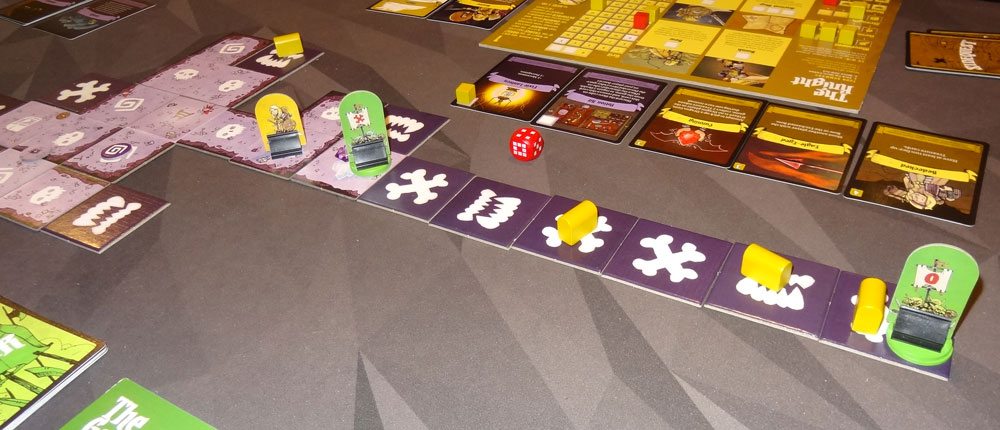
Cave
The Cave gets a hand of 3 cave tiles. Each turn the cave gets to collect Omens, shape the cave, and place a Treasure. Omens are collected based on the number of Crystals and Treasures currently on the map, and can be spent for various abilities, like Rockslides to block off passages or Giant Bats to move things around in the cave.
If there are cave tiles left, you play one (face-down) anywhere connected to the map. Once all of the cave tiles have been played, you start collapsing the cave instead–you get to remove 3 tiles per turn, though you have to collapse edges first. Treasures must be placed on dark tiles that are unoccupied and don’t already have Treasure on them. When you place tiles on your turn, you must place Crystal tiles if you have them in your hand.
In addition, any time a map tile is revealed by any player, you fill in the adjacent spaces with dark tiles (but these do not need to be Crystal tiles). When the Knight activates an Event tile, you get to draw the top 3 Events, choose one to play, and put the other two back at the bottom of the deck. When the Knight gets a Treasure, you do the same thing with 2 Treasure cards.
The Cave wins if 5 Crystal tiles have been collapsed.
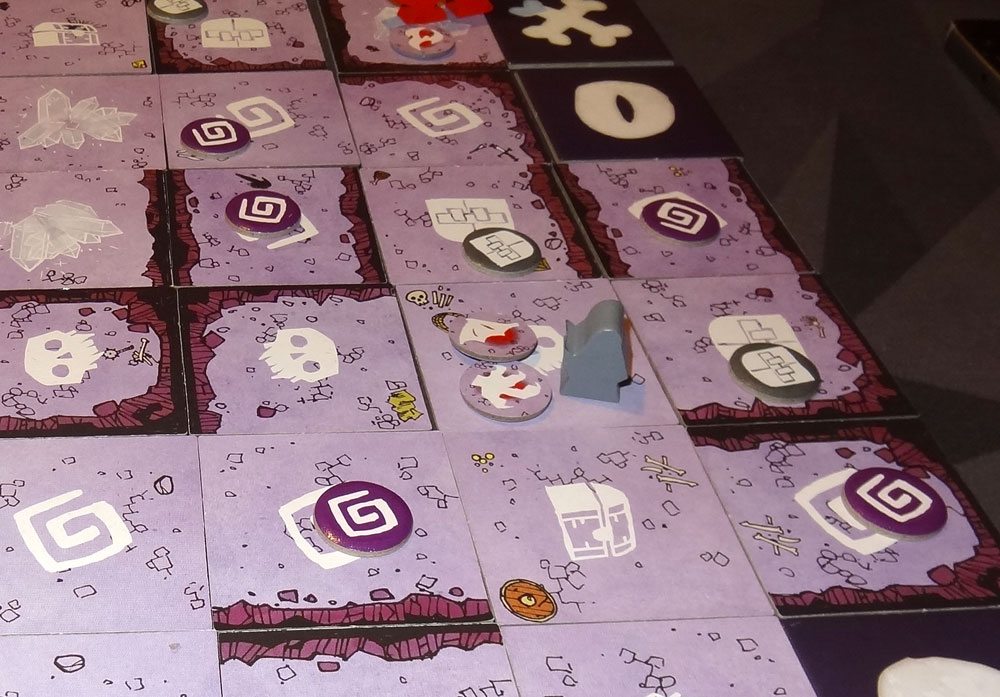
Thief
The Thief has been cursed by a sorcerer: whenever he dies, he just finds himself back at the entrance of the cave, Groundhog Day–style, until he has collected enough treasure to pay off his debt.
You start at the entrance tile on your first turn. You have 3 Stat tiles: 2, 3, and 4. Each turn, you assign these three Stat tokens to your three stats: Movement, Stealth, and Thievery. Movement indicates how many spaces you may move during your turn. Stealth determines whether other characters can see and attack you, and whether you can Pickpocket or Backstab the other characters. Thievery is how many action cubes you get for the turn.
The Thief has various actions listed on the board, along with the number of action cubes each action requires. For instance, picking up loot takes 1 cube; climbing over a wall takes 2 cubes. There are some actions that may require a die roll; using more cubes will make the die roll easier or even make it an automatic success. Vault tiles contain vaults that you can attempt to unlock for treasure—these vaults cannot be opened by any other players. You can also take actions to lower your Loot Drop level—that’s the value that other players will get when they kill you.
If you die, you drop everything you’re carrying on that tile, remove the Thief from the board, and then reappear on the entrance tile on your next turn. If you make it back to the entrance tile with loot, you get to turn loot into upgrades: there are various spaces on the board, from flipping over your Stat tokens (to make them more powerful) to reducing the number of cubes needed to take particular actions. However, whenever you stash treasures, your Loot Drop level returns to 3.
If the Thief stashes 6 treasures, he wins.

Terrain tiles are an optional feature. Whenever an event tile is revealed, the Cave player (or active player if there’s no Cave) chooses and places one of the special Terrain tiles on the board, as close to the active player as possible, though not touching or diagonally adjacent to any other Terrain tiles. (Note that you do not automatically surround Terrain tiles with dark tiles—if you step off the edge of a Terrain tile, a tile is automatically drawn and placed.) Here are the various types:
- Canyon: Two impassable tiles with a bridge across the center.
- Lake: A large square that is considered lit for Goblin’s movement.
- Magma: Harms the Knight, Goblins, and Thief if they end movement on it.
- Mushroom Forest: Anyone in the Mushroom Forest is protected from all outside effects and attacks, and ranged attacks cannot be made from inside the forest.
- Pits: All 3 Pits are placed as one Terrain—one close to the active player, and the other two as far from each other as possible. All Pits are considered adjacent to each other, but you may not end movement on a Pit.
- River: Entering the River lets you move for free any number of spaces in the direction of current. Moving against the current requires regular movement costs. Goblins lose 1 population when they enter the River, and lose 1 population per space when moving against the current.
The Variant cards are used when you have fewer than 4 players—the rulebook explains which ones to use, and which objectives are changed depending on the players involved. For instance, the Knight will need to smash crystals if the Dragon isn’t present, or the Goblins will smash crystals if the Knight isn’t present. When there isn’t a Cave player, there’s usually a Past Plunder card to add treasures to the board, and every player will add tiles or remove tiles as the cave grows and then collapses. In that case, tiles are drawn from the stack instead of chosen by a player, and Event and Treasure cards are drawn at random as well.
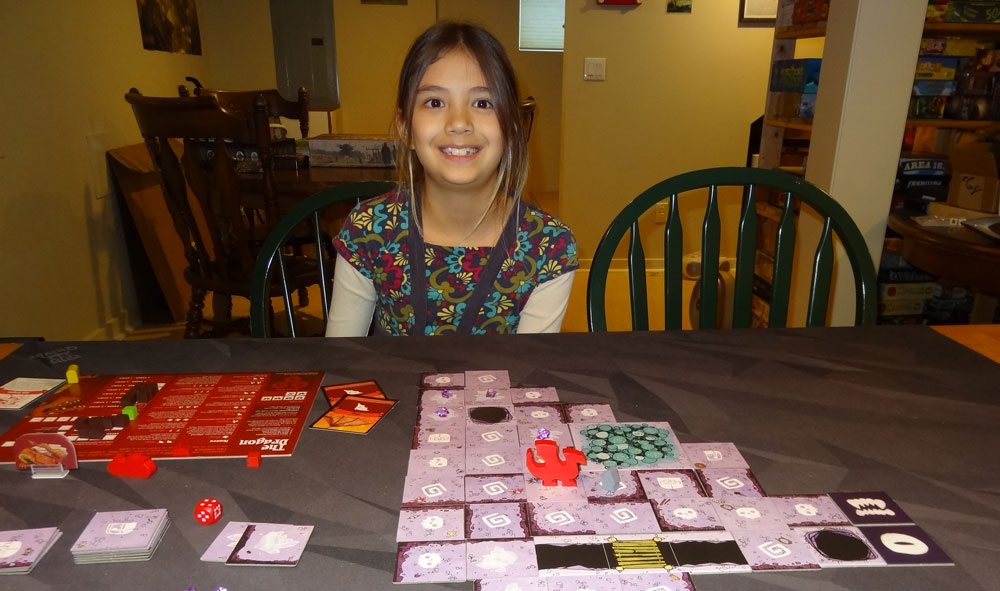
The Verdict
Patrick Leder at Leder Games knew that I was a big fan of it, and when he offered me the chance to get one of the advance production copies, I agreed immediately. Vast had been one of my most anticipated Kickstarter deliveries this year, and I was not disappointed.
I’ll just come right out and say it: I like Vast so much it’s almost embarrassing. The amount of time I’ve spent playing it, talking about it, and thinking about it eclipses almost anything else I’ve been playing lately (though it has a ways to go before it will catch up to Pathfinder Adventure Card Game). My kids say it’s currently their favorite game, and I’m very excited that this will be available soon so that everyone else can finally start playing it.
Of course, the biggest problem then may be that I’m over-hyping it, and you’ll all be disappointed. So, to that end, I’ll start with the things that are not great about Vast. So, here are the reasons I gave it a 9.5 on BoardGameGeek instead of a 10:
- The aforementioned cardboard pawns would have been better with different plastic bases.
- The game takes a long time to teach. I mentioned this in my original review, too, but basically you’re teaching 5 different games at once. With the individual rule sheets, you can pass those out and everyone can read their own pages, but not everyone enjoys reading rules and it may still be hard to really grasp the game as a whole by looking only at your portion. It’s important to understand what the other players can and can’t do.
- While the five roles seem fairly balanced in terms of victory conditions, they do not take the same amount of time. The Goblins have a longer turn at the start but it stays about the same length throughout. The Knight, Dragon, and Cave start with very short turns but start increasing as they level up and gain access to a wider range of abilities. The Thief’s turn is the shortest, and even with upgrades remains fairly short. So in a 5-player game, the Thief will spend the least time actually playing and the most time sitting and watching everyone else. While I happen to think Vast is fun to watch, not everyone will enjoy the lengthy downtime between turns.
- The game as a whole is long. Mostly this becomes an issue in a 4- or 5-player game, but it’s a game that can fall prey to Analysis Paralysis, because most of the roles offer a lot of different choices to make. Of course, in general I really do like having a lot of choices, and I don’t enjoy games that are primarily (or entirely) luck-based. But do be prepared, the first time you play this with 5 players, to spend about 2 hours playing it (or more). Fortunately, once players are familiar with the rules, the games will go more quickly.
Okay, with that out of the way, I can gush some more.

My verdict from my original review still mostly stands. The Goblin has been simplified and streamlined from the prototype, although the turns can still be a little long (you’re controlling three tribes, after all). It’s still absolutely fascinating to watch this game in progress, and to see these completely disparate roles mesh together into a single game. I’m really in awe of the way that designers David Somerville and Patrick Leder were able to make this thing work—particularly when a game ends and everyone else was within a turn of winning. Now, that doesn’t happen every time, but I’ve found that more often than not, it’s a pretty tight competition. Even when it seemed like a player was out of the running, they often catch up by the end.
During the Kickstarter, you were limited to particular roles: for instance you always had a Knight and Goblin, no matter what. I appreciate the fact that you can now play with any combination of roles, and the game will have a different feel with each combination. (Some combinations will be easier for new players than others.) The work that went into playtesting and balancing these roles is amazing. The replayability on this game is incredible: even with the same group of players, you can play at least five times in a row, just trading roles, and it will be a different experience.
I love the idea of the Difficulty cards, which were added in later. By tweaking things like starting health and number of Cave tiles in the game, you can adjust the difficulty per player, and also shorten or lengthen the game. Basically, the cards make it easier to achieve a role’s objective, which then means that the game will be shorter. Give everyone “Easiest,” and the game will be extra short. I’m still tuning exactly what difficulty level to give to my kids, but I love that it’s possible to tweak the game for new or experienced players. I like the idea of the mega-campaign, though I’ll hold off on that until all the players involved are familiar with the game.
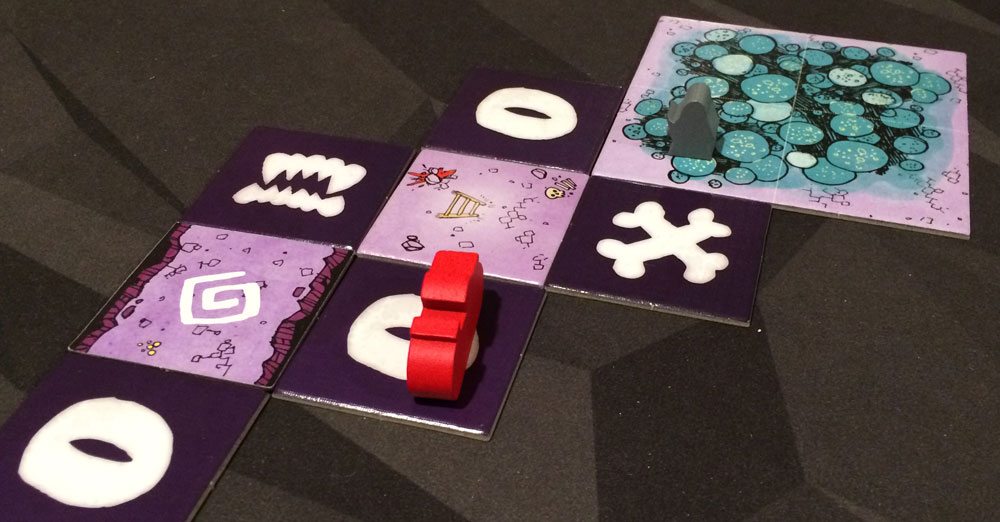
I’ve only used the Terrain tiles once so far (mostly because I keep teaching the game to new players), but they’re a lot of fun, and don’t actually complicate the game too much. So far I’ve tried something like 6 of the 30 permutations (including a solo Knight game), and I’ve set myself the silly goal to play all possible permutations. Of course, that may be tricky because somebody always wants to play as the Cave. And why not? What other game is there where you get to play as the environment?
In terms of ease of learning, I would say that less-experienced players could start with the Dragon and the Knight, and maybe the Thief (for those who don’t mind waiting for their turn). The Goblins are a little more complex, and the Cave is probably the most complex. In particular, the Cave is the one most responsible for balancing the other roles against each other, because the Cave wants to prevent everyone from achieving their goals long enough to collapse. It’s also the role with the most player interaction, because the Cave also places tiles (and sometimes cards) on other player’s turns. The other roles may attack each other or steal from each other, but only the Cave interacts with almost everyone else on a regular basis.
If you’re going to teach the game, I often get everyone’s boards set up, and then just get the game started. The Knight’s first turn is generally to explore two tiles: Goblin ambushes can’t affect her yet (because the Goblin won’t have enough strength yet), Cave events won’t do much either (except maybe help the Cave), and a treasure could give her a boost. I usually teach the turns as they happen for the first round, which lets you introduce about half of the rules at a time. In the meantime, the other players have time to study their boards and various abilities.
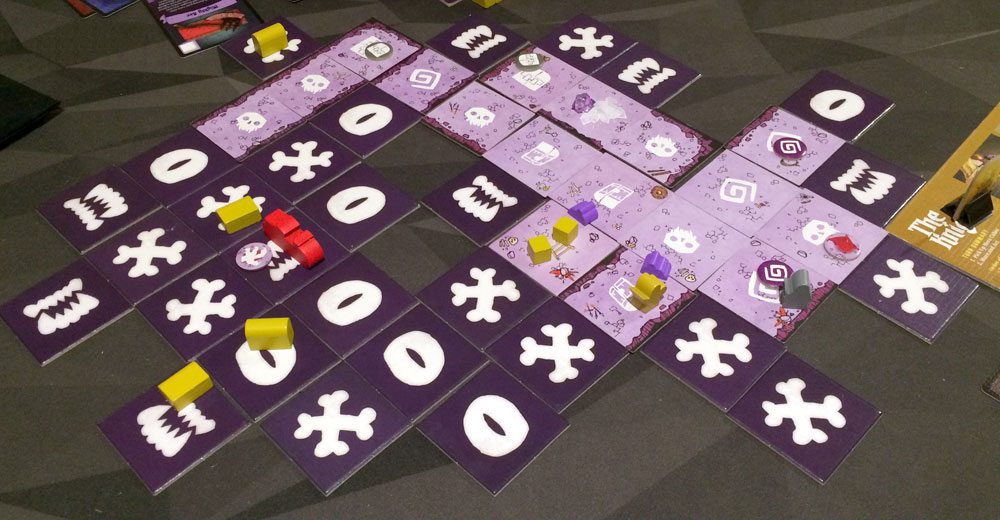
Overall, I am delighted with the way Vast: The Crystal Caverns turned out. With the added content, it was a steal at the Kickstarter backer price. Even the $50 pre-order price seems very reasonable when you consider both the components and the, ahem, vast amount of replayability. If you backed the Kickstarter last fall, you’re in for a real treat. If you didn’t, it’s not too late to get in on one of the best games I’ve played this year. Click here to place a pre-order—games should be shipping out later this summer. It looks like they will also be available at Gen Con for $60. While supplies last, pre-orders will also come with a fancy box sleeve (not included on this advance copy), but once those run out that’s it.
And one more small bit of news: Patrick Leder has shared that he has already been working on playtesting a few more options for expanding the Vast universe, and some of these will be available to see at Gen Con. Vast: The Mysterious Manor will be another stand-alone game with new roles that can be interchanged with The Crystal Caverns, and Ghost and Ghoul will add two new roles to throw into the mix. I’m really excited to see where these will go.
For now, though, I’ve still got another 24 permutations to tackle…
* There were some potential conflicts with the name Trove because of the Trove MMO, and so the publisher decided to change the name rather than risk trademark infringement issues.
Disclosure: Leder Games provided a copy of the game for review.
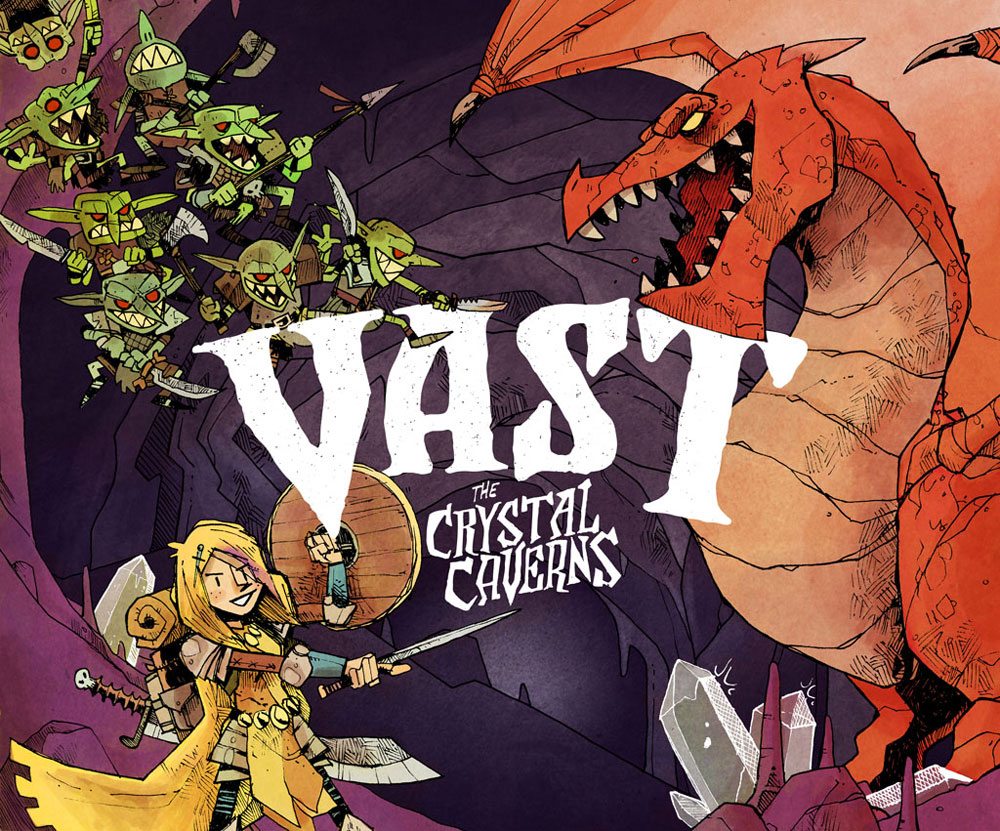

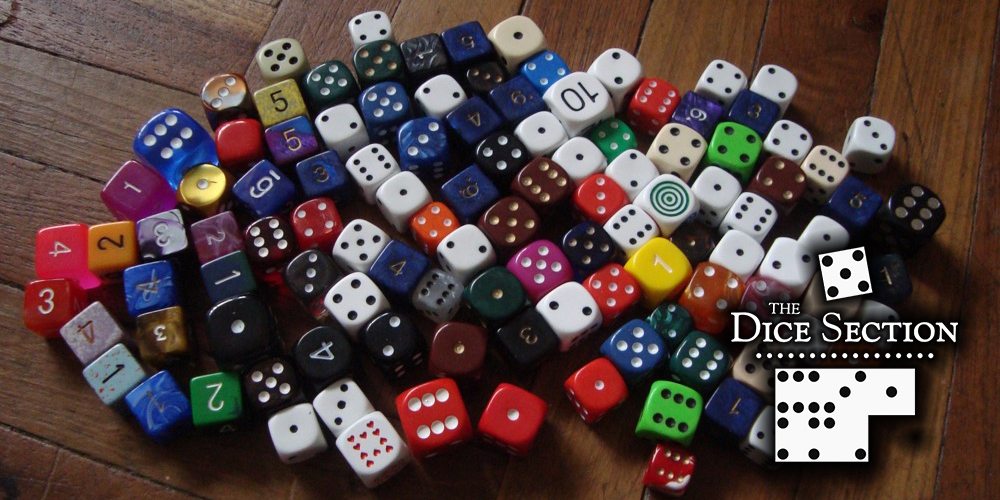


I pre-ordered… do you know if pre-orders can be fulfilled at GenCon?
Very nice review. Can’t wait to get my copy!